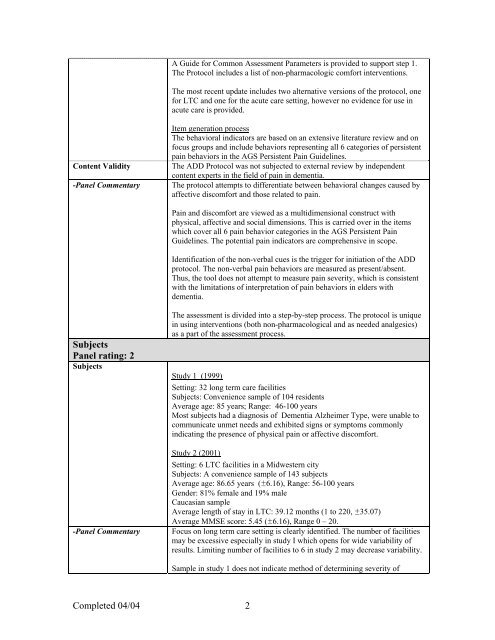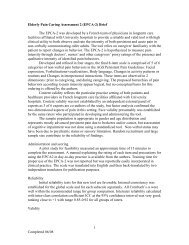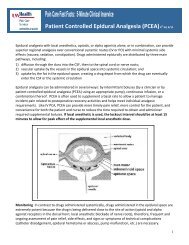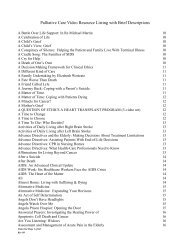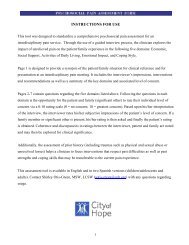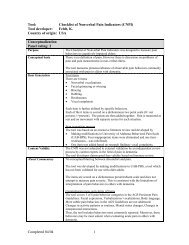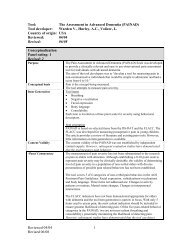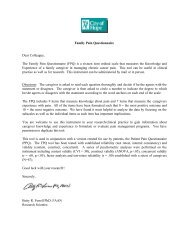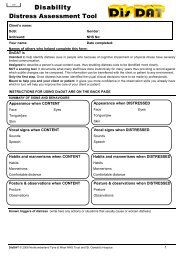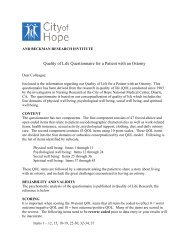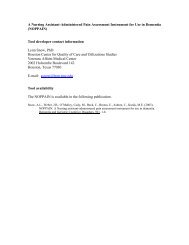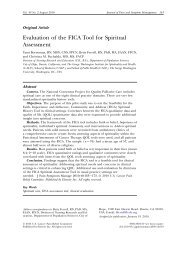The Assessment of Discomfort in Dementia (ADD)
The Assessment of Discomfort in Dementia (ADD)
The Assessment of Discomfort in Dementia (ADD)
You also want an ePaper? Increase the reach of your titles
YUMPU automatically turns print PDFs into web optimized ePapers that Google loves.
A Guide for Common <strong>Assessment</strong> Parameters is provided to support step 1.<br />
<strong>The</strong> Protocol <strong>in</strong>cludes a list <strong>of</strong> non-pharmacologic comfort <strong>in</strong>terventions.<br />
<strong>The</strong> most recent update <strong>in</strong>cludes two alternative versions <strong>of</strong> the protocol, one<br />
for LTC and one for the acute care sett<strong>in</strong>g, however no evidence for use <strong>in</strong><br />
acute care is provided.<br />
Content Validity<br />
-Panel Commentary<br />
Item generation process<br />
<strong>The</strong> behavioral <strong>in</strong>dicators are based on an extensive literature review and on<br />
focus groups and <strong>in</strong>clude behaviors represent<strong>in</strong>g all 6 categories <strong>of</strong> persistent<br />
pa<strong>in</strong> behaviors <strong>in</strong> the AGS Persistent Pa<strong>in</strong> Guidel<strong>in</strong>es.<br />
<strong>The</strong> <strong>ADD</strong> Protocol was not subjected to external review by <strong>in</strong>dependent<br />
content experts <strong>in</strong> the field <strong>of</strong> pa<strong>in</strong> <strong>in</strong> dementia.<br />
<strong>The</strong> protocol attempts to differentiate between behavioral changes caused by<br />
affective discomfort and those related to pa<strong>in</strong>.<br />
Pa<strong>in</strong> and discomfort are viewed as a multidimensional construct with<br />
physical, affective and social dimensions. This is carried over <strong>in</strong> the items<br />
which cover all 6 pa<strong>in</strong> behavior categories <strong>in</strong> the AGS Persistent Pa<strong>in</strong><br />
Guidel<strong>in</strong>es. <strong>The</strong> potential pa<strong>in</strong> <strong>in</strong>dicators are comprehensive <strong>in</strong> scope.<br />
Identification <strong>of</strong> the non-verbal cues is the trigger for <strong>in</strong>itiation <strong>of</strong> the <strong>ADD</strong><br />
protocol. <strong>The</strong> non-verbal pa<strong>in</strong> behaviors are measured as present/absent.<br />
Thus, the tool does not attempt to measure pa<strong>in</strong> severity, which is consistent<br />
with the limitations <strong>of</strong> <strong>in</strong>terpretation <strong>of</strong> pa<strong>in</strong> behaviors <strong>in</strong> elders with<br />
dementia.<br />
Subjects<br />
Panel rat<strong>in</strong>g: 2<br />
Subjects<br />
-Panel Commentary<br />
<strong>The</strong> assessment is divided <strong>in</strong>to a step-by-step process. <strong>The</strong> protocol is unique<br />
<strong>in</strong> us<strong>in</strong>g <strong>in</strong>terventions (both non-pharmacological and as needed analgesics)<br />
as a part <strong>of</strong> the assessment process.<br />
Study 1 (1999)<br />
Sett<strong>in</strong>g: 32 long term care facilities<br />
Subjects: Convenience sample <strong>of</strong> 104 residents<br />
Average age: 85 years; Range: 46-100 years<br />
Most subjects had a diagnosis <strong>of</strong> <strong>Dementia</strong> Alzheimer Type, were unable to<br />
communicate unmet needs and exhibited signs or symptoms commonly<br />
<strong>in</strong>dicat<strong>in</strong>g the presence <strong>of</strong> physical pa<strong>in</strong> or affective discomfort.<br />
Study 2 (2001)<br />
Sett<strong>in</strong>g: 6 LTC facilities <strong>in</strong> a Midwestern city<br />
Subjects: A convenience sample <strong>of</strong> 143 subjects<br />
Average age: 86.65 years (±6.16), Range: 56-100 years<br />
Gender: 81% female and 19% male<br />
Caucasian sample<br />
Average length <strong>of</strong> stay <strong>in</strong> LTC: 39.12 months (1 to 220, ±35.07)<br />
Average MMSE score: 5.45 (±6.16), Range 0 – 20.<br />
Focus on long term care sett<strong>in</strong>g is clearly identified. <strong>The</strong> number <strong>of</strong> facilities<br />
may be excessive especially <strong>in</strong> study I which opens for wide variability <strong>of</strong><br />
results. Limit<strong>in</strong>g number <strong>of</strong> facilities to 6 <strong>in</strong> study 2 may decrease variability.<br />
Sample <strong>in</strong> study 1 does not <strong>in</strong>dicate method <strong>of</strong> determ<strong>in</strong><strong>in</strong>g severity <strong>of</strong><br />
Completed 04/04 2


